British Scones
These British scones are light, fluffy, and more like an American biscuit than the dry, crumbly scones you might be used to. They’re perfect with clotted cream and jam for an English-style afternoon tea.
Whether you’re hosting a baby shower, bridal shower, or a Bridgerton-themed tea party, classic British scones are a must!
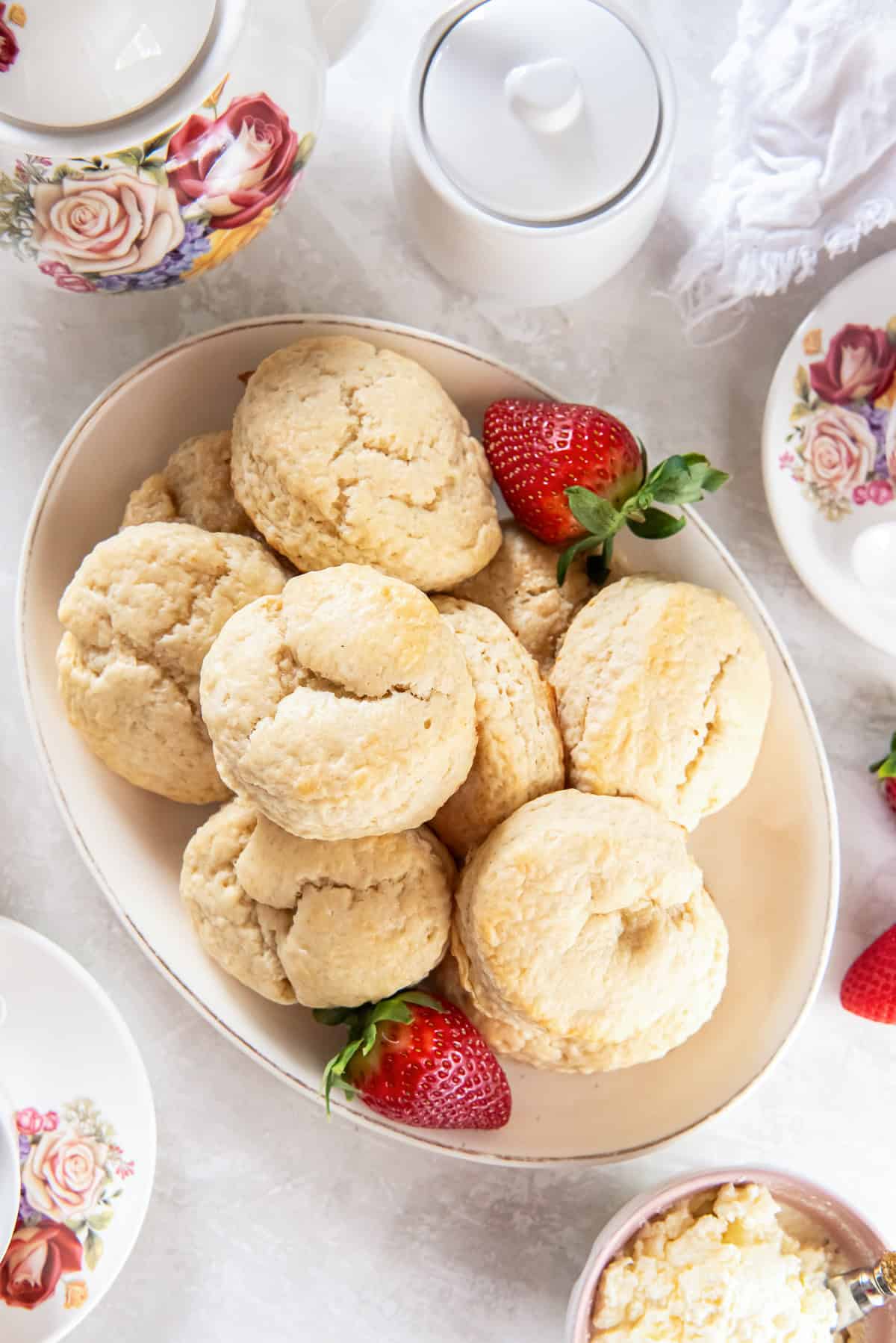
Last year, when we visited British Columbia, I had the absolute pleasure of enjoying afternoon tea at the Fairmont Empress. Alongside an assortment of small bites, they served authentic British scones—an experience that instantly changed my feelings about scones forever.
I learned that proper English scones are tender, airy, and slightly sweet, with a somewhat crisp and crumbly outer texture. They have the shape and rise of an American biscuit, making them perfect for splitting and slathering with clotted cream and jam. So different than the dense, dry texture of the American scones we’re used to in the U.S.
My visit to the Empress left such an impression that when I hosted a double baby shower for my two daughters-in-law last December (Grandbabies! So exciting!), I knew an afternoon tea theme featuring scones was happening. And, thus, the recipe testing process began and I learned some very important things along the way. I’m thrilled to be sharing the recipe, incuding my best tips on how to avoid some of the issues I encountered.
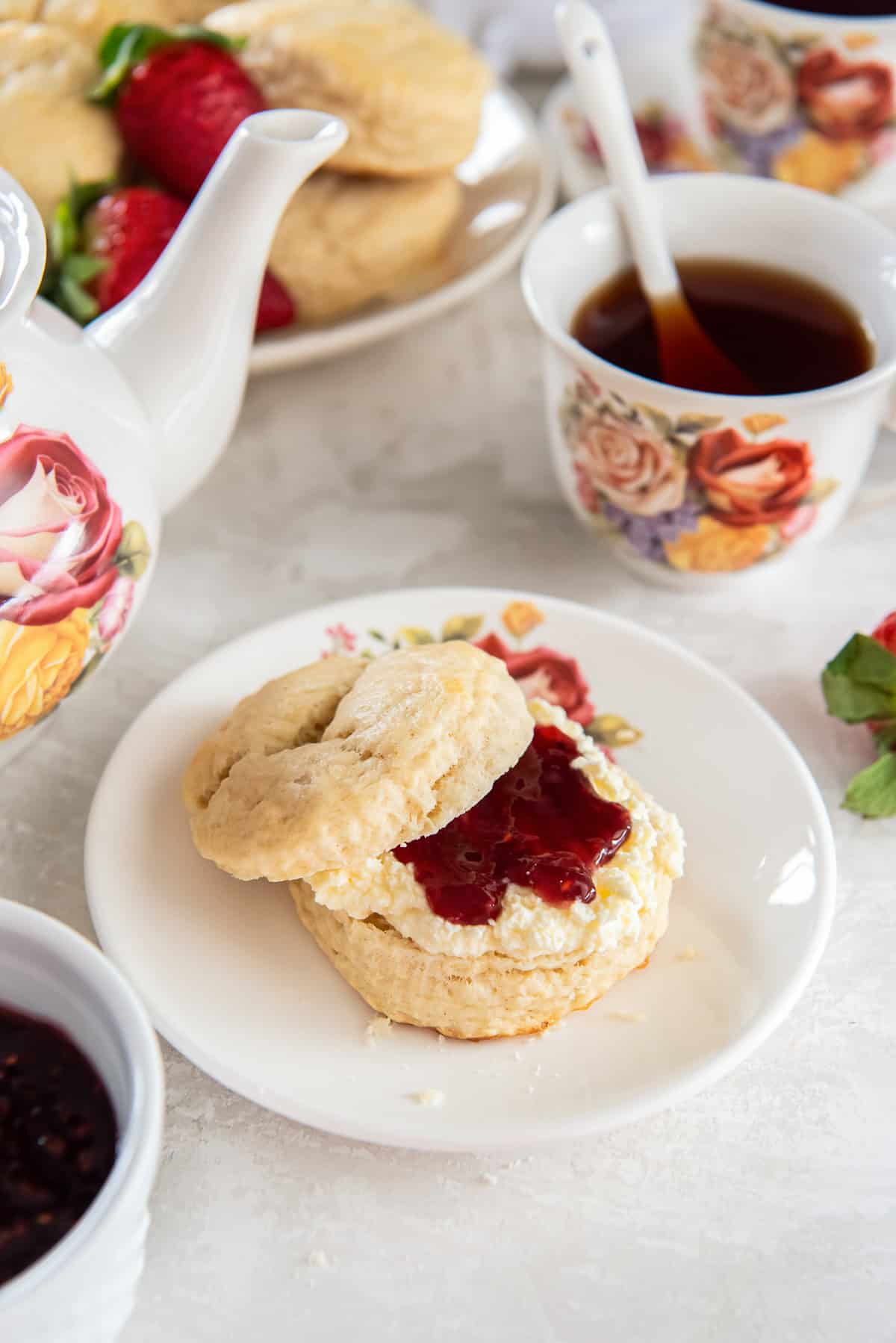
Ingredient Notes
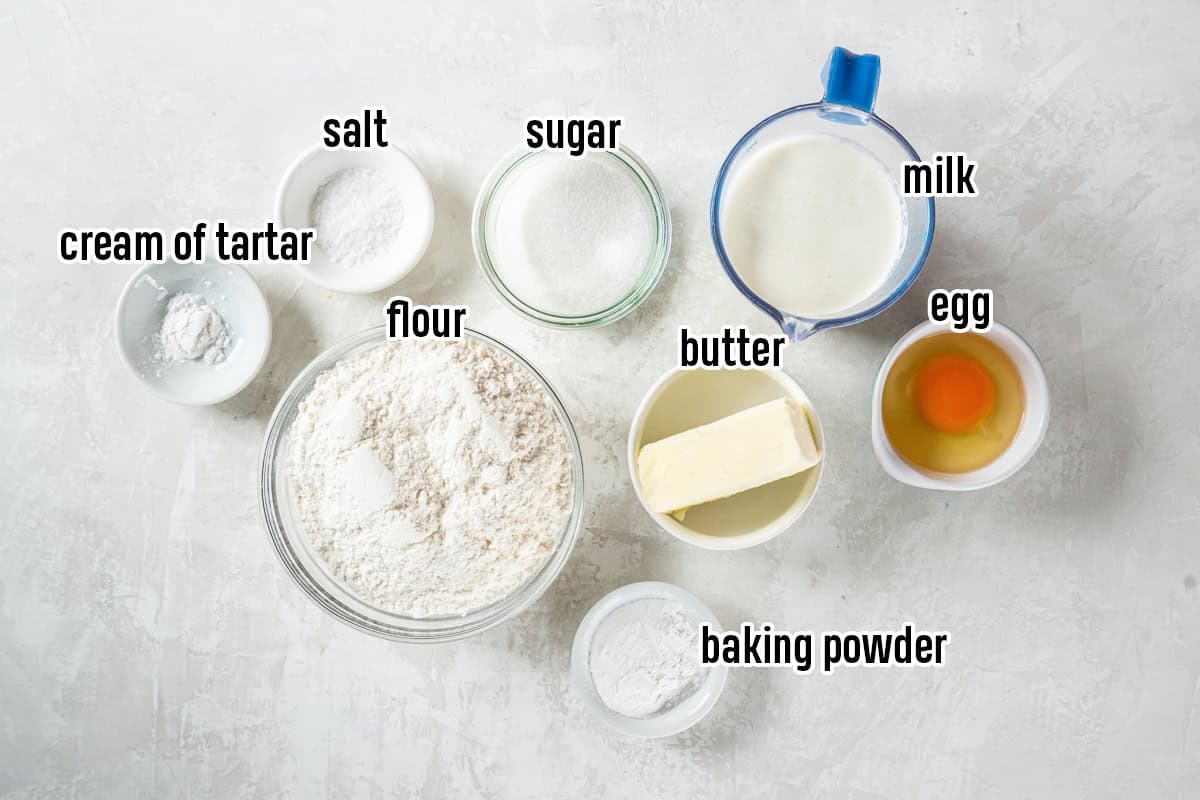
- All-purpose flour: You want to be sure you’re measuring your flour properly for the best result. Instead of dipping your measuring cup in the flour container, spoon the flour into the measuring cup and level if off (spooned and leveled). This ensures the correct flour measurement without overpacking the cup.
- Granulated sugar: Adds a subtle sweetness.
- Baking powder: This recipe calls for a generous amount of baking powder, which is the main leavening agent responsible for the scones’ rise and light, fluffy texture. If you’re concerned about a potential metallic taste, you can opt for aluminum-free baking powder. I’ve tested these scones with both regular and aluminum-free baking powder, and I honestly couldn’t detect any difference in the final result.
- Cream of tartar: I tested the recipe with baking powder alone and didn’t get quite the lift I was looking for. On the next test, I added a small amount of cream of tartar and it worked perfectly with the baking powder to enhance the leavening process. You want them to rise enough so they will easily split apart.
- Salt: Just enough to balance the sweetness and heightens the flavors for a well-rounded taste.
- Unsalted butter: Be sure you start with cold butter and grate it into the flour mixture. This helps to eliminate the possibility of overworking the dough.
- Whole milk: Adds moisture and richness, helping to bind the ingredients together while contributing to the scones’ tender crumb.
- Large egg: Helps add a golden, slightly crisp finish and adds even more richness to the dough.
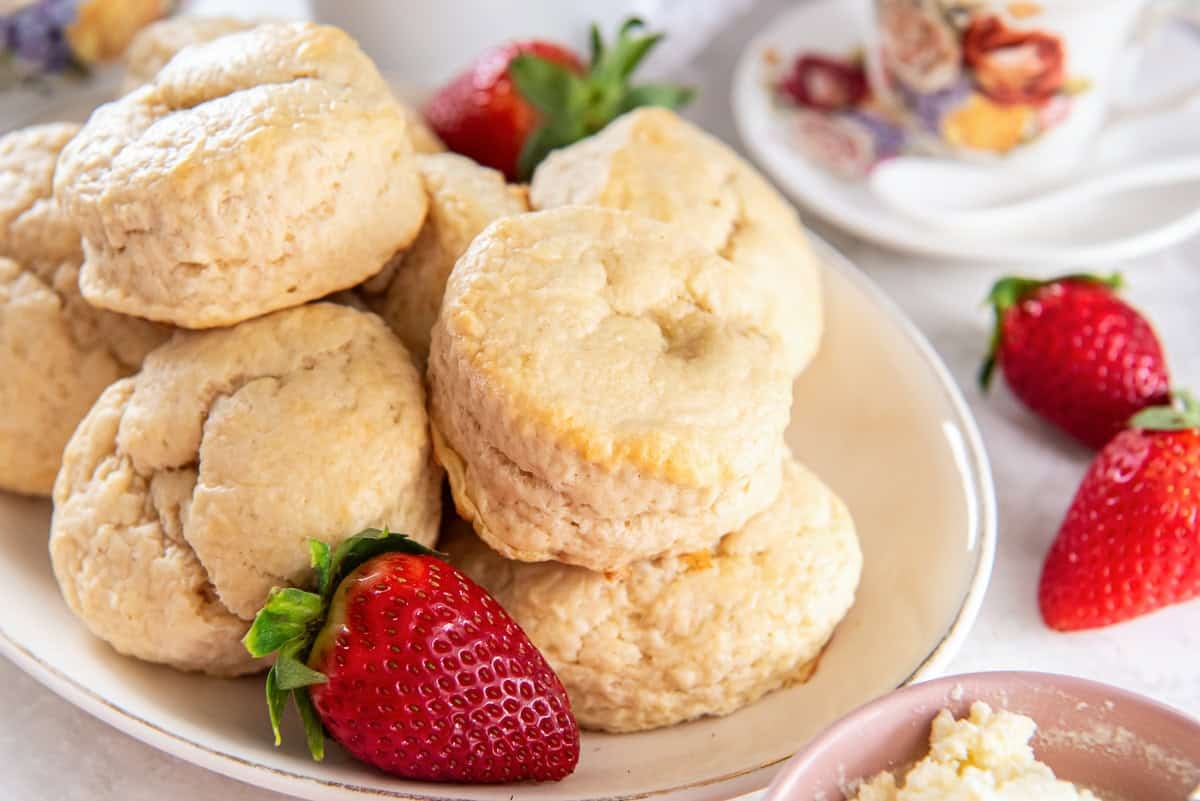
This is a quick overview of how to make this recipe. You’ll find detailed instructions in the recipe card at the end of this post.
How to Make British Scones
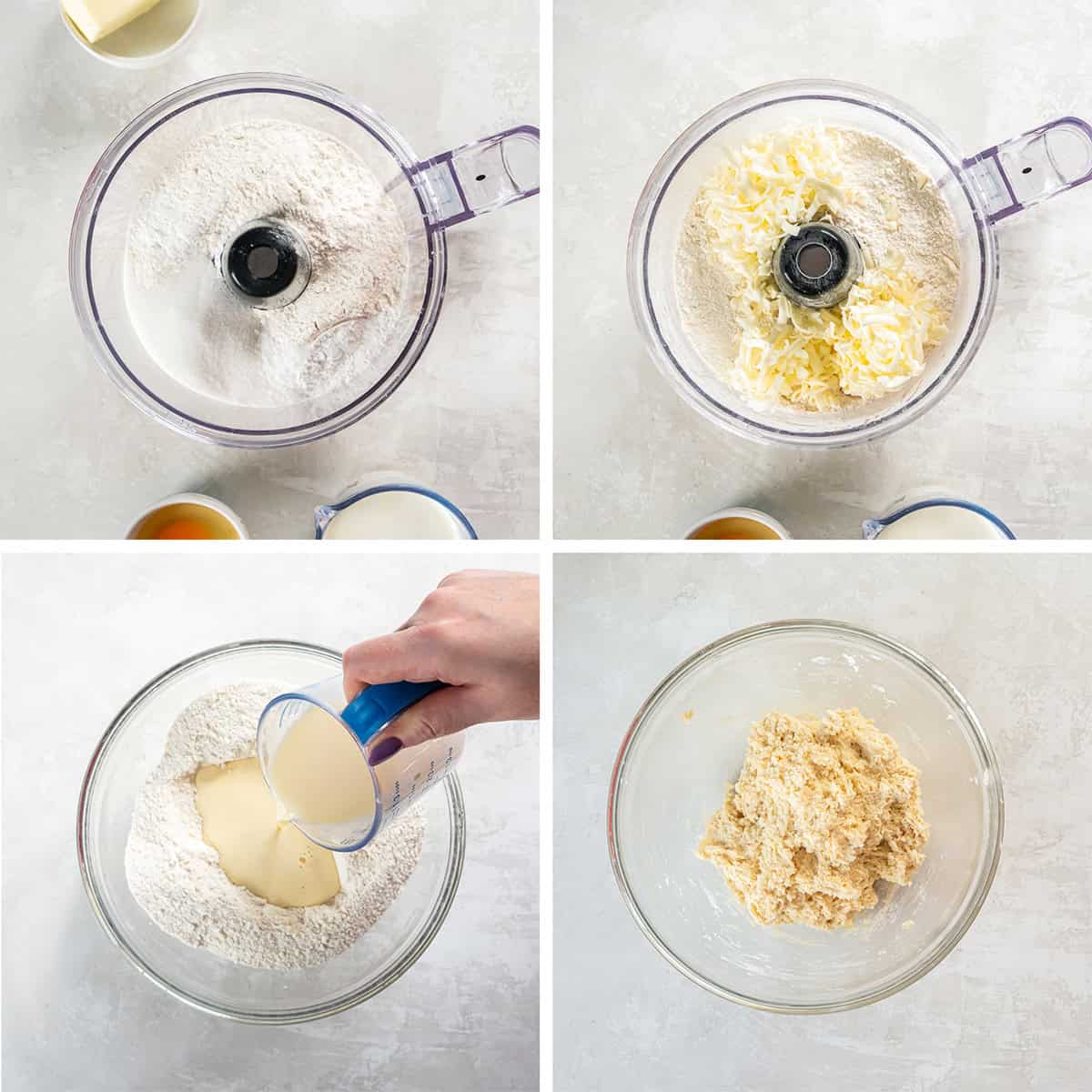
- In a food processor, pulse the flour, sugar, baking powder, cream of tartar, and salt.
- Grate the cold butter into the mixture and pulse until the mixture has a sandy texture and transfer the dry mixture to a large bowl.
- In a small bowl, whisk the egg with the milk. Measure out and reserve 2 tablespoons of this mixture to a small bowl to use as an egg wash later. Make a well in the dry ingredients and pour the remaining milk and egg mixture into the center.
- Using a rubber spatula or wooden spoon, stir until it begins to come together into a rough dough. Flour your hands and work the dough in the bowl just until you can form it into a rough ball and all of the dry mixture has been picked up from the bottom of the bowl (it won’t be smooth – don’t overwork).
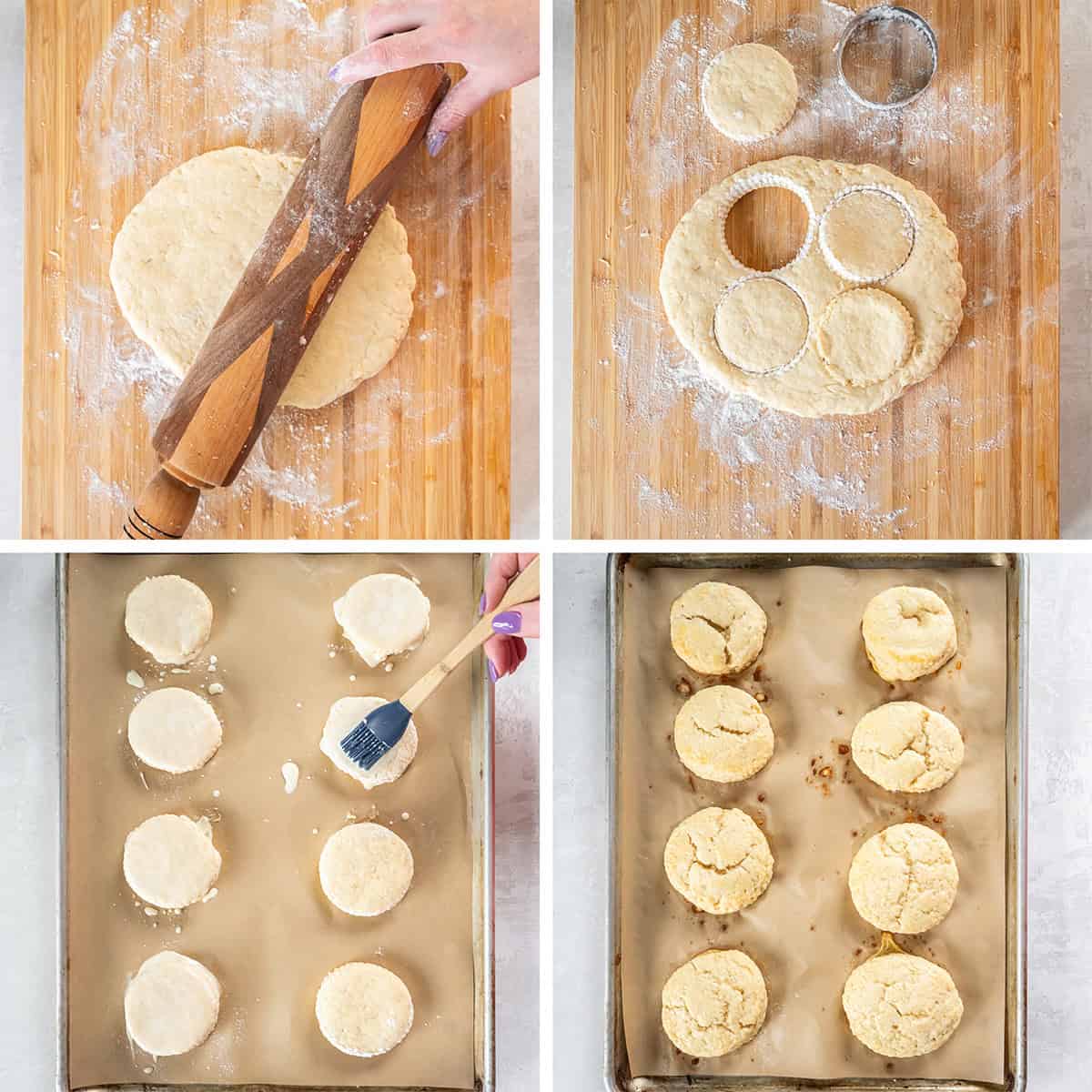
- Transfer the dough to a lightly floured board form it into a neat, somewhat smooth ball. Sprinkle it with a little flour and roll it out to a circle about 1- inch thick.
- Use a 2 ½-inch biscuit cutter to cut as many scones as you can – about 4. Pull together the dough scraps and roll them out twice more to cut the remaining 4 scones.
- Place the scones on a large lined baking sheet and brush the tops with the reserved egg wash.
- Bake in a preheated 400 degree F oven for 11 to 13 minutes, until they’ve risen and are light golden brown on the tops and deeper golden brown on the bottoms. Immediately transfer the scones to a serving platter or a wire rack.
Tips for the Best British Scones
These are the issues I ran into during the testing process along with the solutions I found that worked. Learn from my mistakes!
Don’t overwork the dough. It shouldn’t be worked with your hands until the butter is smooth – just until the dough comes together into a ball.
Roll the dough to the correct thickness. On my first test, I rolled the dough too thin and the scones didn’t rise high enough to separate easily. Be sure the dough is 1-inch to no less than ¾-inch thick before cutting the scones.
Use the proper cutting techinique. Make sure not to twist the biscuit cutter at all when cutting the circles. Push it straight down toward your work surface, otherwise they may not rise as tall.
Bake the scones on a lined baking sheet. Line your baking sheet with parchment paper or a silicone baking mat. If you bake them on an un-lined dark baking sheet it’s likely the bottoms will burn.
How to Serve Scones
It’s traditional to serve British Scones with clotted cream and jam. I looked at recipes for clotted cream and honestly, it seemed like too much of a process to deal with at home. So, instead, I found it in the dairy section of a high-end grocery store near us and paired it with some berry jam for the full experience.
What is clotted cream?: Clotted cream is a rich, thick cream made by heating full-fat cow’s milk and then letting it cool slowly, allowing the cream to rise to the top and form “clots” or a thick, velvety texture. It has a slightly sweet flavor and a dense, creamy consistency that is much thicker than regular cream or whipped cream.
Where to find clotted cream: If you can’t locate clotted cream in a store near you, it’s available on Amazon and other online retailers. You can also just serve the scones with softened butter and jam or see my suggestion below for a substitution.
Substitute for clotted cream: Mascarpone cheese has a creamy, rich texture that can work well as a substitute for clotted cream. Just mix it with a bit of powdered sugar for sweetness.
Jam: Set out jam in small bowls, either one type or a variety of flavors. We love strawberry jam and other berry jams. Apricot and peach jam are also wonderful on scones.
Looking for more small bite ideas for your afternoon tea? Finger sandwiches are a great choice! I filled a couple different types of sandwich bread with my Curry Chicken Salad, Pesto Chicken Salad, and Classic Egg Salad, and sliced them into rectangles for tea sandwiches. I set a platter of scones next to tiered trays filled with finger sandwiches and other small bites, and they were a huge hit with our party guests.
Don’t forget to include some sweet treats. I baked a batch of my mom’s Easy Lemon Bars.
Make it easy on yourself and pick up a variety of other small hors d’oeuvres and sweets, like mini quiche, mini cream puffs, and macarons—Costco has an excellent selection of these goodies.
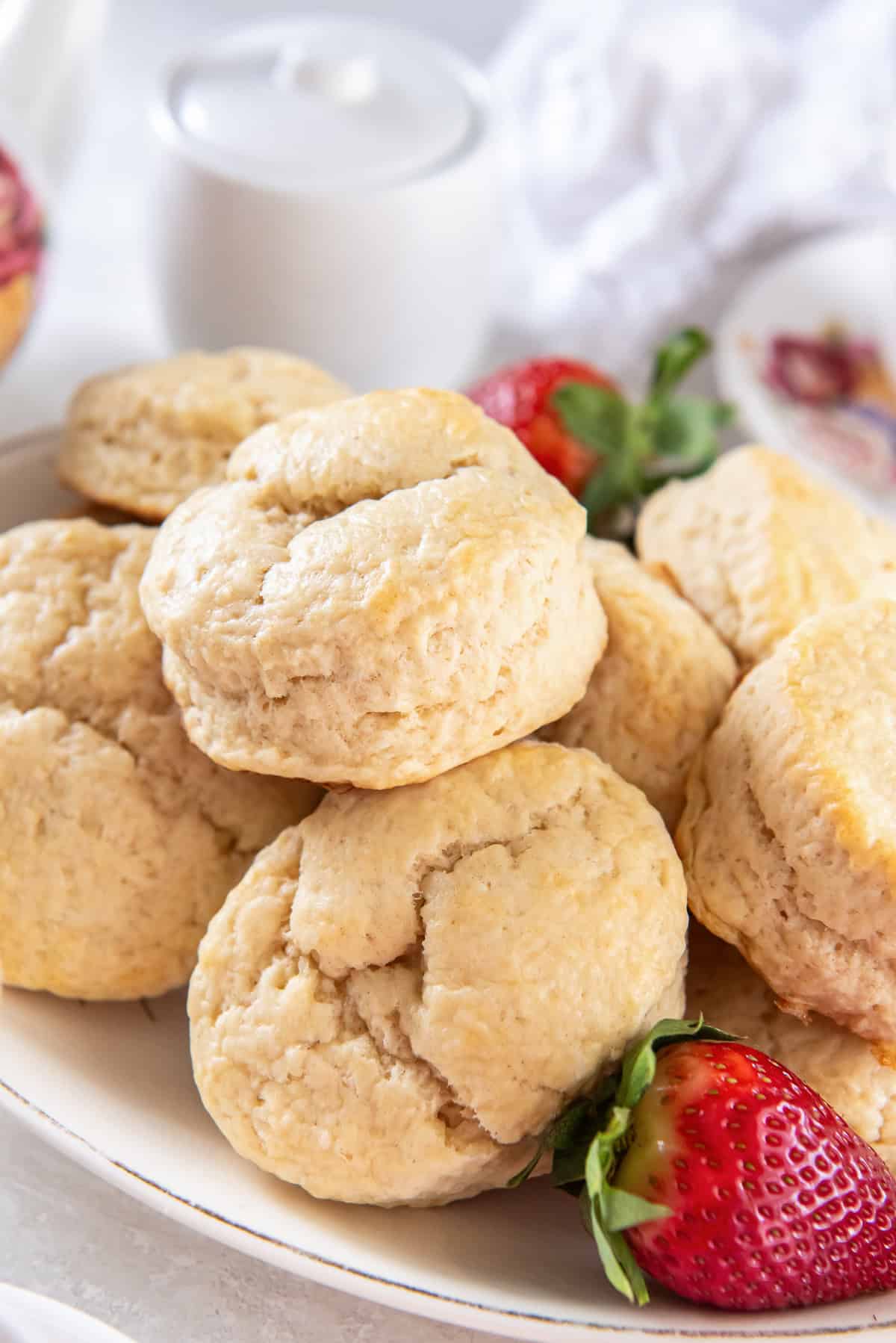
Make-Ahead and Storage Tips
Scones are best baked fresh and served warm. If you are baking them in advance, I recommend warming them briefly in the oven set to 300 degrees F for 5 to 10 minutes or very briefly in the microwave. They can be stored at room temperature or frozen for a longer life.
- Room Temperature: Transfer cooled scones to an airtight container and store in a cool, dry place for a day or two.
- Freeze: You can freeze baked scones in an airtight container for up to 1 month. To serve, just unwrap and thaw them at room temperature for about an hour and reheat as directed above. You can also freeze the cut-out, unbaked scones on a parchment-lined baking sheet until firm, then transfer them to a bag or airtight container and freeze for up to 1 month. When ready to bake, cook them directly from frozen, adding an extra 2 to 3 minutes to the baking time.
Sign up for my free newsletter for all the latest recipes and join me on Facebook, Instagram and Pinterest for more cooking inspiration!

British Scones
These British scones are light, fluffy, and more like an American biscuit than the dry, crumbly scones you might be used to. They’re perfect with clotted cream and jam for an English-style afternoon tea.
Servings: 8 scones
Instructions
Preheat the oven to 400 degrees F. with an oven rack set in the center of the oven. Line a large baking sheet with parchment paper or a silicone baking mat and set it aside.
In a food processor, pulse the flour, sugar, baking powder, cream of tartar, and salt.
Grate the cold butter into the mixture and pulse about 8 times (or as needed) until the butter is distributed and the mixture has a sandy texture. Transfer it to a large mixing bowl.
In a small bowl, whisk the egg with the milk. Measure out and reserve 2 tablespoons of this mixture to a small bowl to use as an egg wash later.
Make a well in the dry ingredients and pour the remaining milk and egg mixture into the center. Using a rubber spatula or wooden spoon, stir until it begins to come together into a rough dough. Flour your hands and work the dough in the bowl just until you can form it into a rough ball and all of the dry mixture has been picked up from the bottom of the bowl (it won’t be smooth – don’t overwork).
Scatter a small amount of flour over a cutting board and transfer the dough to the board. Work the dough again, forming it with your hands into a neat, somewhat smooth ball. Sprinkle the top of the ball of dough with a very small amount of flour (to prevent the rolling pin from sticking) and roll it out to a circle about 1- inch thick and no less than ¾-inch thick.
Use a 2 ½-inch biscuit cutter to cut as many circles as you can – about 4. Make sure not to twist the cutter at all when cutting the circles. Push straight down toward your work surface, otherwise they may not rise as tall. Pull together the dough scraps and roll them out twice more to cut the remaining 4 scones (I usually get 4, 3, 1 with a total of 3 roll-outs).
Place the scones on the prepared baking sheet and brush the tops with the reserved egg wash.
Bake for 11 to 13 minutes, until they’ve risen and are light golden brown on the tops and deeper golden brown on the bottoms. Immediately transfer the scones to a serving platter or a wire rack (remove from the baking sheet to prevent bottoms from browning any further.)
Serve warm with jam and clotted cream.
Notes
Scones are best baked fresh and served warm. If you are baking them in advance, I recommend warming them briefly in the oven set to 300 degrees F for 5 to 10 minutes or very briefly in the microwave. They can be stored at room temperature or frozen for a longer life.
Room Temperature: Transfer cooled scones to an airtight container and store in a cool, dry place for a day or two.
Freeze: You can freeze baked scones in an airtight container for up to 1 month. To serve, just unwrap and thaw them at room temperature for about an hour and reheat as directed above. You can also freeze the cut-out, unbaked scones on a parchment-lined baking sheet until firm, then transfer them to a bag or airtight container and freeze for up to 1 month. When ready to bake, cook them directly from frozen, adding an extra 2 to 3 minutes to the baking time.
Nutrition
Serving: 1 scone · Calories: 223 kcal · Carbohydrates: 32 g · Protein: 5 g · Fat: 9 g · Saturated Fat: 5 g · Polyunsaturated Fat: 1 g · Monounsaturated Fat: 2 g · Trans Fat: 0.3 g · Cholesterol: 42 mg · Sodium: 164 mg · Potassium: 307 mg · Fiber: 1 g · Sugar: 7 g · Vitamin A: 281 IU · Calcium: 122 mg · Iron: 2 mg
Nutrition information is automatically calculated using generic ingredients, and is an estimate not a guarantee. For more accurate results, please refer to the labels on your ingredients at home.


